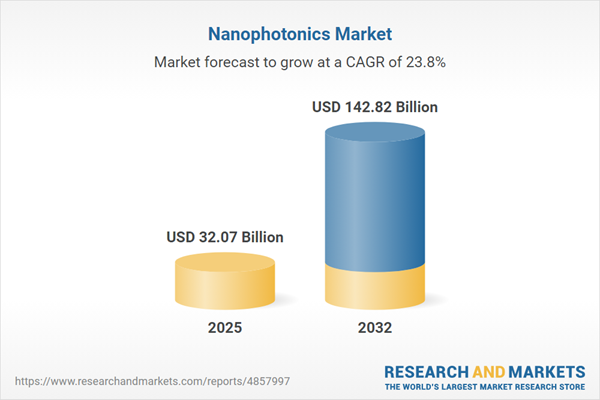Speak directly to the analyst to clarify any post sales queries you may have.
Nanophotonics is redefining enterprise digital infrastructures, providing senior decision-makers with agile, light-based solutions that streamline technology alignment and boost operational adaptability. This report offers executives a succinct, data-driven overview of the nanophotonics market, focusing on its value for industry transformation and scalable digital innovation.
Market Snapshot: Nanophotonics Market Size and Growth
The global nanophotonics market has achieved a valuation of USD 25.89 billion in 2024 and is projected to grow to USD 32.07 billion by 2025 and USD 142.82 billion by 2032. This robust compound annual growth rate reflects mounting investment in advanced optical technologies as industries pursue greater efficiency and resilience. Growth is propelled by modernization of communication networks, demand for precision in sensing systems, and an industry-wide shift toward intelligent infrastructure. Decision-makers in telecommunications, healthcare, and industrial automation are integrating nanophotonic platforms to optimize processes and strengthen digital competitiveness.
Scope & Segmentation of the Nanophotonics Market
This report supplies actionable intelligence across all essential market segments, supporting executives in strategic targeting and adaptation to industry change:
- Device Types: Detectors, lasers, modulators, waveguides, imaging systems, optical frameworks, biosensors, and surface plasmon resonance sensors all underpin precision integration and high data accuracy within complex systems.
- Key Technologies: Metamaterials, nanowires, photonic crystals, plasmonics, and quantum dots lead to smaller, more efficient products and more effective light management for industrial applications.
- Material Categories: Dielectric materials, metals, polymers, and semiconductors enable consistent manufacturing outcomes and support robust product reliability in various settings.
- Applications: Electronics, defense, aerospace, diagnostics, advanced sensing, manufacturing, and telecommunications are advancing process optimization, contributing to efficiency and automation in dynamic markets.
- Regions: The Americas, Europe, the Middle East and Africa (with emphasis on the UK, Germany, Saudi Arabia), and Asia-Pacific including China, Japan, India, South Korea, and Australia, each present distinct growth opportunities shaped by regulatory environments and local investment patterns.
- Key Companies: MKS Instruments, Hamamatsu Photonics, Coherent, IPG Photonics, Lumentum Operations, Jenoptik, AIXTRON, Thorlabs, Nanosys, and Nanoco Group are driving technological progress and influencing competitive dynamics across core segments.
Key Takeaways for Senior Decision-Makers
- Nanophotonic solutions facilitate resilience by enabling flexible response to operational changes and enhancing infrastructure stability in evolving and established markets.
- Integrated device designs simplify the deployment and scaling of optical technologies, resulting in productivity enhancements in sectors such as manufacturing and healthcare.
- Harmonizing advances in semiconductor and photonic technology improves accuracy in imaging and increases data transfer efficiency, supporting both automated and mission-critical operations.
- Collaboration between technology enterprises and research institutions accelerates the development and adoption of innovative materials and components, ensuring organizations remain aligned with critical shifts in the industry.
- Modular and scalable product architectures strengthen business continuity as priorities diversify, ensuring readiness for expansion as operational complexity intensifies.
- Strategic management of intellectual property and alliances supports navigation of regulatory landscapes and unlocks new avenues for market engagement and growth.
Tariff Impact: United States 2025 Policy Effects
Planned changes in United States trade tariffs for 2025 are influencing nanophotonics organizations to revise supply chain structures. Companies are prioritizing the development of domestic manufacturing capacity, expanding supplier bases, and utilizing adaptable component sourcing. These approaches help secure continuity and maintain reliability as regulatory frameworks evolve.
Methodology & Data Sources: Robust Nanophotonics Research
This research is grounded in comprehensive expert interviews, detailed patent evaluations, and continuous monitoring of sector developments. All information is independently validated, providing senior leaders with high-integrity data essential for strategic decisions.
Why This Nanophotonics Report Matters for Market Leaders
- Strategic insights support effective resource allocation and proactive investment planning, aligning with shifts in digital market demands and compliance requirements.
- Granular segmentation and regulatory analysis help new entrants and established firms position competitively and manage exposure to market risks.
- Action-oriented recommendations optimize supply chain management and streamline entry into new markets, enabling agile responses to emerging industry challenges.
Conclusion
This analysis enables senior executives to drive growth, lead informed transformation, and foster ongoing innovation in the nanophotonics market.
Additional Product Information:
- Purchase of this report includes 1 year online access with quarterly updates.
- This report can be updated on request. Please contact our Customer Experience team using the Ask a Question widget on our website.
Table of Contents
3. Executive Summary
4. Market Overview
7. Cumulative Impact of Artificial Intelligence 2025
Companies Mentioned
The companies profiled in this Nanophotonics market report include:- MKS Instruments, Inc.
- Hamamatsu Photonics K.K.
- Coherent, Inc.
- IPG Photonics Corporation
- Lumentum Operations LLC
- Jenoptik AG
- AIXTRON SE
- Thorlabs, Inc.
- Nanosys, Inc.
- Nanoco Group plc
Table Information
| Report Attribute | Details |
|---|---|
| No. of Pages | 199 |
| Published | October 2025 |
| Forecast Period | 2025 - 2032 |
| Estimated Market Value ( USD | $ 32.07 Billion |
| Forecasted Market Value ( USD | $ 142.82 Billion |
| Compound Annual Growth Rate | 23.7% |
| Regions Covered | Global |
| No. of Companies Mentioned | 11 |









